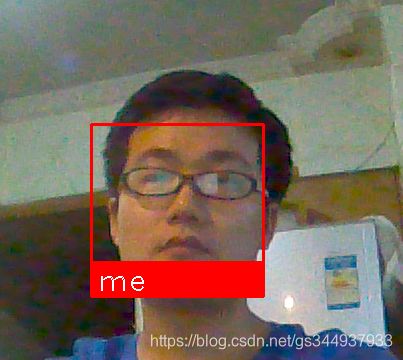
Jetson Nano 使用dlib库
发布日期:2021-05-06 19:08:38
浏览次数:24
分类:精选文章
本文共 5285 字,大约阅读时间需要 17 分钟。
参考的:
其中到第7步的时候,face_recognition 提供的源代码不对,提示如下:
gs@nano:~/01_nano/dlib_face_recognition$ python3 dlib_face_recognition.py select timeoutVIDIOC_DQBUF: Resource temporarily unavailableTraceback (most recent call last): File "dlib_face_recognition.py", line 81, insmall_frame = cv2.resize(frame, (0, 0), fx=0.25, fy=0.25)cv2.error: OpenCV(4.1.0) /home/gs/02_github/nano_build_opencv/opencv/modules/imgproc/src/resize.cpp:3718: error: (-215:Assertion failed) !ssize.empty() in function 'resize'gs@nano:~/01_nano/dlib_face_recognition$
经过一翻检查后,发现应该是打开摄像头的代码不对,因此修改下面的代码:
import face_recognitionimport cv2import numpy as np# This is a demo of running face recognition on live video from your webcam. It's a little more complicated than the# other example, but it includes some basic performance tweaks to make things run a lot faster:# 1. Process each video frame at 1/4 resolution (though still display it at full resolution)# 2. Only detect faces in every other frame of video.# PLEASE NOTE: This example requires OpenCV (the `cv2` library) to be installed only to read from your webcam.# OpenCV is *not* required to use the face_recognition library. It's only required if you want to run this# specific demo. If you have trouble installing it, try any of the other demos that don't require it instead.def gstreamer_pipeline( capture_width=1280, capture_height=720, display_width=1280, display_height=720, framerate=60, flip_method=0,): return ( "nvarguscamerasrc ! " "video/x-raw(memory:NVMM), " "width=(int)%d, height=(int)%d, " "format=(string)NV12, framerate=(fraction)%d/1 ! " "nvvidconv flip-method=%d ! " "video/x-raw, width=(int)%d, height=(int)%d, format=(string)BGRx ! " "videoconvert ! " "video/x-raw, format=(string)BGR ! appsink" % ( capture_width, capture_height, framerate, flip_method, display_width, display_height, ) )# Get a reference to webcam #0 (the default one)#video_capture = cv2.VideoCapture(0)video_capture = cv2.VideoCapture(gstreamer_pipeline(flip_method=0), cv2.CAP_GSTREAMER)# Load a sample picture and learn how to recognize it.obama_image = face_recognition.load_image_file("me.png")obama_face_encoding = face_recognition.face_encodings(obama_image)[0]# Load a second sample picture and learn how to recognize it.biden_image = face_recognition.load_image_file("biden.jpg")biden_face_encoding = face_recognition.face_encodings(biden_image)[0]# Create arrays of known face encodings and their namesknown_face_encodings = [ obama_face_encoding, biden_face_encoding]known_face_names = [ "me", "Joe Biden"]# Initialize some variablesface_locations = []face_encodings = []face_names = []process_this_frame = Truewhile True: # Grab a single frame of video ret, frame = video_capture.read() # Resize frame of video to 1/4 size for faster face recognition processing small_frame = cv2.resize(frame, (0, 0), fx=0.25, fy=0.25) # Convert the image from BGR color (which OpenCV uses) to RGB color (which face_recognition uses) rgb_small_frame = small_frame[:, :, ::-1] # Only process every other frame of video to save time if process_this_frame: # Find all the faces and face encodings in the current frame of video face_locations = face_recognition.face_locations(rgb_small_frame) face_encodings = face_recognition.face_encodings(rgb_small_frame, face_locations) face_names = [] for face_encoding in face_encodings: # See if the face is a match for the known face(s) matches = face_recognition.compare_faces(known_face_encodings, face_encoding) name = "Unknown" # # If a match was found in known_face_encodings, just use the first one. # if True in matches: # first_match_index = matches.index(True) # name = known_face_names[first_match_index] # Or instead, use the known face with the smallest distance to the new face face_distances = face_recognition.face_distance(known_face_encodings, face_encoding) best_match_index = np.argmin(face_distances) if matches[best_match_index]: name = known_face_names[best_match_index] face_names.append(name) process_this_frame = not process_this_frame # Display the results for (top, right, bottom, left), name in zip(face_locations, face_names): # Scale back up face locations since the frame we detected in was scaled to 1/4 size top *= 4 right *= 4 bottom *= 4 left *= 4 # Draw a box around the face cv2.rectangle(frame, (left, top), (right, bottom), (0, 0, 255), 2) # Draw a label with a name below the face cv2.rectangle(frame, (left, bottom - 35), (right, bottom), (0, 0, 255), cv2.FILLED) font = cv2.FONT_HERSHEY_DUPLEX cv2.putText(frame, name, (left + 6, bottom - 6), font, 1.0, (255, 255, 255), 1) # Display the resulting image cv2.imshow('Video', frame) # Hit 'q' on the keyboard to quit! if cv2.waitKey(1) & 0xFF == ord('q'): break# Release handle to the webcamvideo_capture.release()cv2.destroyAllWindows()

发表评论
最新留言
表示我来过!
[***.240.166.169]2025年04月10日 05时41分19秒
关于作者

喝酒易醉,品茶养心,人生如梦,品茶悟道,何以解忧?唯有杜康!
-- 愿君每日到此一游!
推荐文章
上周热点回顾(5.2-5.8)
2021-05-09
上周热点回顾(5.9-5.15)
2021-05-09
上周热点回顾(8.8-8.14)
2021-05-09
.NET跨平台之旅:将示例站点升级至 .NET Core 1.1 Preview 1
2021-05-09
上周热点回顾(1.16-1.22)
2021-05-09
上周热点回顾(1.23-1.29)
2021-05-09
上周热点回顾(3.20-3.26)
2021-05-09
上周热点回顾(4.24-4.30)
2021-05-09
[故障公告]博客站点1台负载均衡遭遇流量攻击,造成联通与移动用户无法正常访问
2021-05-09
上周热点回顾(5.1-5.7)
2021-05-09
上周热点回顾(5.29-6.4)
2021-05-09
上周热点回顾(6.19-6.25)
2021-05-09
云计算之路-阿里云上:docker swarm 集群故障与异常
2021-05-09
上周热点回顾(2.19-2.25)
2021-05-09
云计算之路-阿里云上:博客web服务器轮番CPU 100%
2021-05-09
云计算之路-阿里云上:服务器CPU 100%问题是memcached连接数限制引起的
2021-05-09
上周热点回顾(3.26-4.1)
2021-05-09
故障公告:IIS应用程序池停止工作造成博客站点无法访问
2021-05-09
【故障公告】极验验证码故障造成无法登录与注册
2021-05-09